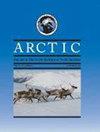Terrain Features and Architecture of Wolverine (Gulo gulo) Resting Burrows and Reproductive Dens on Arctic Tundra
IF 0.8
4区 地球科学
Q4 ENVIRONMENTAL SCIENCES
引用次数: 1
Abstract
Burrowing species rely on subterranean and subnivean sites to fulfill important life-history and behavioral processes, including predator avoidance, thermoregulation, resting, and reproduction. For these species, burrow architecture can affect the quality and success of such processes, since characteristics like tunnel width and chamber depth influence access by predators, thermal insulation, and energy spent digging. Wolverines (Gulo gulo) living in Arctic tundra environments dig burrows in snow during winter for resting sites and reproductive dens, but there are few published descriptions of such burrows. We visited 114 resting burrows and describe associated architectural characteristics and non-snow structure. Additionally, we describe characteristics of 15 reproductive den sites that we visited during winter and summer. Although many resting burrows were solely excavated in snow, most incorporated terrain structures including cliffs, talus, river shelf ice, thermokarst caves, and stream cutbanks. Burrows typically consisted of a single tunnel leading to a single chamber, though some burrows had multiple entrances, branching tunnels, or both. Tunnels in resting burrows were shorter than those in reproductive dens, and resting chambers were typically located at the deepest part of the burrow. Reproductive dens were associated with snowdrift-forming terrain features such as streambeds, cutbanks on lake edges, thermokarst caves, and boulders. Understanding such characteristics of Arctic wolverine resting and reproductive structures is critical for assessing anthropogenic impacts as snowpack undergoes climate-driven shifts.北极苔原狼獾栖息穴和繁殖密度的地形特征和结构
穴居物种依靠地下和亚地下场所来完成重要的生活史和行为过程,包括捕食者的躲避、体温调节、休息和繁殖。对于这些物种来说,洞穴结构会影响这些过程的质量和成功,因为隧道宽度和洞穴深度等特征会影响捕食者的进入、隔热和挖掘所花费的能量。生活在北极苔原环境中的狼獾(Gulo-Gulo)在冬天在雪地里挖洞作为休息场所和繁殖窝点,但很少有关于这种洞穴的公开描述。我们参观了114个休息洞穴,并描述了相关的建筑特征和非雪结构。此外,我们还描述了我们在冬季和夏季访问的15个繁殖巢穴的特征。尽管许多休息洞穴都是在雪地里挖掘的,但大多数都包含了地形结构,包括悬崖、距骨、河架冰、热溶洞和溪流路堑。洞穴通常由一条通往一个洞穴的隧道组成,尽管有些洞穴有多个入口、分支隧道或两者兼而有之。休息洞穴中的隧道比繁殖洞穴中的短,休息室通常位于洞穴的最深处。繁殖巢穴与形成雪堆的地形特征有关,如河床、湖泊边缘的河岸、热溶洞和巨石。了解北极狼獾休息和繁殖结构的这些特征,对于评估雪堆发生气候变化时的人为影响至关重要。
本文章由计算机程序翻译,如有差异,请以英文原文为准。
求助全文
约1分钟内获得全文
求助全文
来源期刊

Arctic
地学-环境科学
CiteScore
2.30
自引率
0.00%
发文量
51
审稿时长
6-12 weeks
期刊介绍:
Arctic is a peer-reviewed, primary research journal that publishes the results of scientific research
from all areas of Arctic scholarship. Original scholarly papers in the physical, social, and biological
sciences, humanities, engineering, and technology are included, as are book reviews,
commentaries, letters to the editor, and profiles of significant people, places, or events of northern
interest
 求助内容:
求助内容: 应助结果提醒方式:
应助结果提醒方式:


